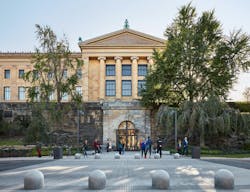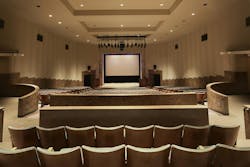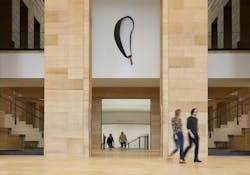Bringing the past back to life
PLATINUM AWARD – 2021 BD+C RECONSTRUCTION AWARDS
Philadelphia Museum of Art Core Project, Philadelphia
PROJECT INFORMATION:
Project size: 141,500 sf (22,000 sf of galleries, 71,200 sf of public spaces, 48,300 sf back of house)
Project cost: $233 million
Construction time: March 2017 – May 2021
Delivery method: CM at Risk Guaranteed Maximum Price
RECONSTRUCTION TEAM:
Submitting firm and MEP Engineer: Altieri
Owner/Developer: Philadelphia Museum of Art
Architect, AOR, Interior Designer: Gehry Partners LLP
Structural Engineer: Magnusson Klemencic Associates
Construction Manager: LF Driscoll
Client Representative: Aegis Property Group
JUDGES’ COMMENTS:
“Based on the statement, it took 10 years’ worth of planning and development for this multi-phased expansion and renovation project. Despite this being a Gehry project, it doesn’t really look like something he would do. The team took into account lack of certain amenities, closed off areas to the building and awareness of MEP/technology that was needed for the project. It looked at what was lacking and executed it accordingly. The biggest challenge for the team was keeping the building in operation during the renovations, which was hard due to the vibration and dust.”
“Difficult construction (occupied reno + artwork complexities), reinventing space that was unused, keeping to the original design intent, incorporating modern MEP into a beautiful existing structure. This is hard to do!”
NARRATIVE:
This reconstruction was the culmination of two decades of planning, design, and construction. It focused on renewing the museum’s infrastructure, and opening up the core of this 640,000-sf Beaux-Arts building, which dates back to 1928. The construction for this project alone took four years to complete.
The redesign honors the integrity of the original architectural vision, with minimal intrusion to the fabric of the historic building. During reconstruction, the building remained open to the public, and the ReCon team—which numbered around 1,500 people—had to resolve several structural surprises.
REOPENING A DORMANT CORRIDOR
The project homed in on two areas of the museum:
•The renovated north entrance includes a new public entrance to the museum with improved ticketing and visitor information services, and direct access to the Vaulted Walkway, main store, and education classrooms. (All told, the project added 90,000 sf of gallery space and amenities, with a design that logically transitions between new and existing spaces.)
The Vaulted Walkway is a 640-ft corridor spanning the entire north-south axis of the museum. Prior to this reconstruction, it hadn’t been open to the public for nearly 50 years. The ground-floor Walkway is distinguished by its strikingly beautiful Guastavino tile vaulted ceiling. The corridor leads to the museum store and a new espresso bar that has overhead access to natural light.
•Lenfest Hall, on the west side of the first floor, was completely renovated, and now provides a view to a new public space—Williams Forum, previously Van Pelt Auditorium—via the museum’s Great Stair Hall. Williams Forum leads to Lenfest Hall via a new glass-and-stone staircase clad in Kasota limestone, the same material used by the museum’s original architects and sourced from the same quarry. Open views of the staircase enhance visitors’ orientation and experience.
CONSTRUCTION CHALLENGES
When the Forum was excavated, the ReCon team discovered the existing foundations were 15 ft higher than the field shown on the drawings. To support the existing primary structural footings for the building above, the team installed flashcrete, rock dowels, and shotcrete in a series of 4-ft lifts to get the Forum’s new floor level.
Other changes included relocating several back-office functions, which added nearly 23,000 sf of new gallery space within the existing building, created a 10,000-sf Learning Center, and offered more amenities such as a restaurant, café, and retail.
Mechanical, electrical, plumbing, fire protection, security, IT/AV, and other building infrastructure systems were all either replaced or upgraded to meet the museum’s expanded programming requirements. During construction, temporary systems were installed so that the museum could stay open. When shutdowns were required to connect or disconnect existing, temporary, or new systems, they occurred mostly at night.
The mechanical units and ductwork required for the new galleries were significantly more complicated than the HVAC systems that dated back to the mid 1970s. For one thing, the headroom in the existing lower level was insufficient. So the ReCon team designed half of the ductwork to be located underground. Ducts were carefully routed around deep column footings to avoid any structural surcharge from the footing loads. When the columns’ depth proved too shallow, the design team revised the below-grade duct sizes and routing pathways, and provided additional support to some column footings.
This was just one example of this project’s structural unknowns. Another found the geometry and locations of numerous footings differing markedly from the original as-built drawings. “The logistics needed to carve out the heart of the building without shutting it down was nothing short of an amazing accomplishment, and a testament to the paramount importance of team collaboration,” said Bill Childers, Senior Associate with Gehry Partners, and the project’s architect. “The successful completion could never have been accomplished without careful, thorough and highly detailed planning and coordination [among] the Museum, Design Team, and Contractor.”





